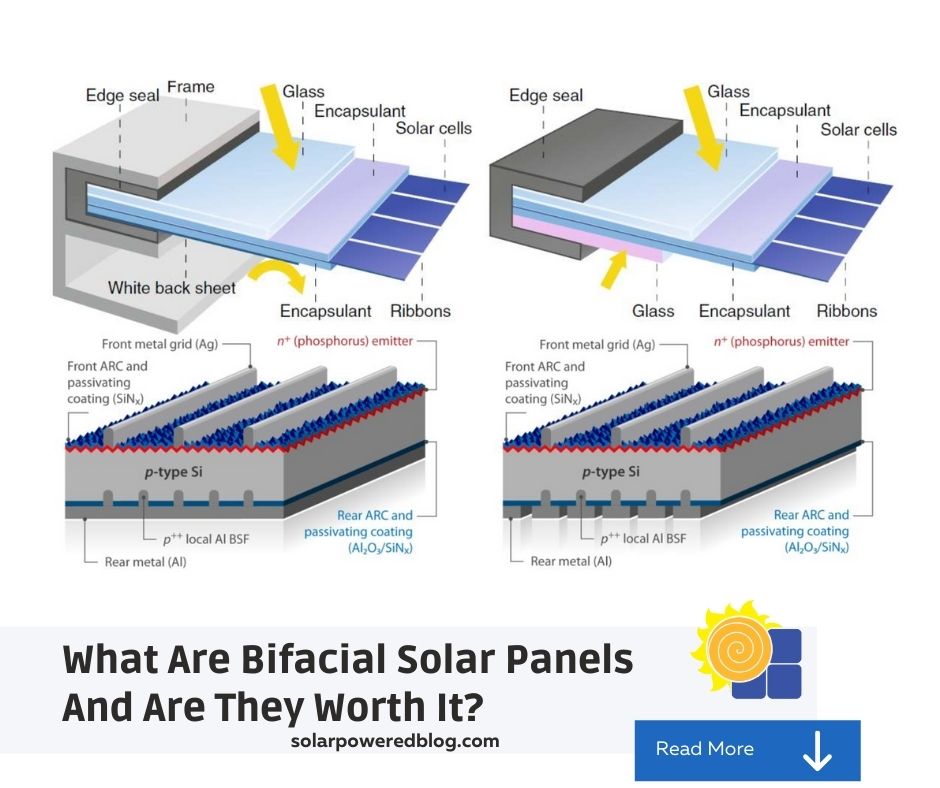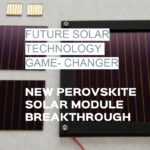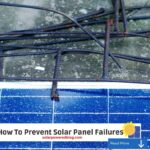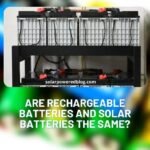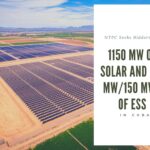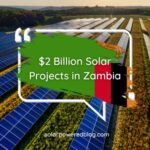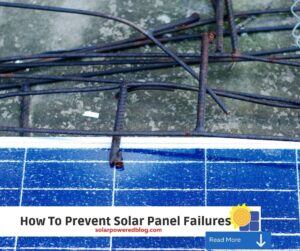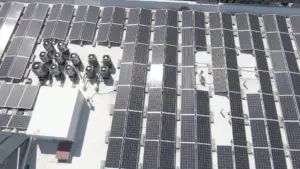Are you looking for a better energy solution? Or thinking of installing bifacial solar panels to upgrade from traditional solar panels? In this article, we’ll talk more about bifacial solar panels, how they work, what they are, and much more.
Lately, bifacial solar panels have drawn attention for their ability to absorb light on both sides. The advantage is, they generate higher energy, are weather-resistant, durable, and worth the investment you put in.
So without further ado, let’s get on with it!
What Is A Bifacial Solar Panel?
As the name suggests, a bifacial solar panel is double-sided and can generate power on both sides. They are highly efficient as compared to monofacial solar panels. Hence, in whichever direction the sun shines, it can capture energy with increased power production.
These transparent and slim solar panels are generally made of glass, and they can either be framed or frameless.
Besides generating energy, they also require less space and are more effective on reflective surfaces like roofs, swimming pools etc.
Thus, it captures every light that gets reflected from the ground, also known as albedo light or any scattered light mirrored back at the solar cells.
Differences Between Bifacial And Typical Solar Panels?
As previously mentioned, bifacial solar panels can absorb and generate power from the front and rear sides. While on the other hand, typical solar panels are monofacial with a conventional cell structure that traps energy only from the front side.
Bifacial panels have either dual glass or clear backsheets, whereas typical solar panels have opaque backsheets. In addition, bifacial solar panels are also more expensive than monofacial solar. However, bifacial panels are currently popular among households or offices for their durability and UV resistance.
Overview of the Evolution and Development of Bifacial Photovoltaic Cells
The idea of using bifacial photovoltaic (PV) cells dates back to the early days of the solar industry. Japanese researcher H. Mori proposed a bifacial PV cell design as early as 1960 and had successfully developed a working prototype by 1966. Around the same time, Russian and Spanish researchers also explored the potential uses of bifacial PV cells.
The Russians were the first to deploy bifacial PV modules, using them in their space program in the 1970s. In 1980, Andrés Cuevas and his colleagues in Spain documented the ability of bifacial PV cells to capture reflected light (albedo) from light-colored surfaces and increase their power output by 50%. This was a significant milestone in the development of bifacial PV technology.
The high cost of producing bifacial PV cells led to a slow adoption of this technology in terrestrial applications. One of the earliest documented field applications of bifacial PV technology was a vertical photovoltaic noise barrier deployed in 1997 along the A1 motorway in Zurich, Switzerland. The barrier used 10 kW of bifacial PV modules oriented in a north-south direction. The first signs of commercialization in North America emerged about a decade later when Sanyo introduced its first UL-listed HIT Double bifacial PV modules.

The majority of crystalline silicon photovoltaic (PV) cells were made of p-type silicon with a light-opaque aluminum back contact until recently. These monofacial cells, known as aluminum back-surface field cells (Al-BSF), can only accept light from the front.
So, advanced cell designs that use a localized back contact that only requires metallization of a portion of the cell’s rear side include passivated emitter and rear cell (PERC), passivated emitter rear totally diffused (PERT), passivated emitter rear locally diffused (PERL), and silicon heterojunction with 15 thin layer (HIT).
In terms of market share, bifacial photovoltaic cells, modules, and systems are rapidly eclipsing monofacial PV technologies. This is because new cell designs have replaced opaque, monolithic back surface foil contacts with isolated contacts, which allows light to enter the cell from the back side.
Minor modifications to cell processing steps have resulted in bifacial solar cells with rear side efficiencies ranging from more than 60% to more than 90% of the front side.
Overall, the evolution and development of bifacial PV cells has led to significant advancements in solar energy technology, making it a more viable and efficient source of electricity.
Bifacial PV Modules Test Standards and Certifications
Experts from the IEC-appointed working groups are currently reviewing existing standards and determining whether new standards are required to address bifacial PV technologies. They are specifically in charge of PV modules and technical aspects of PV systems. Photovoltaic modules are covered by four sets of IEC standards.

IEC TS 60904-1-2:2019 states that it “describes procedures for the measurement of the current-voltage (I-V) characteristics of bifacial photovoltaic devices in natural or simulated sunlight. It is applicable to single PV cells, sub-assemblies of such cells or entire PV modules.”
For end customers, the lack of a precise description of the nominal power for bifacial PV modules is a disadvantage. The power rating is usually based on the frequently used STC output power of the front side, with some manufacturers including an anticipated contribution from the back.
Right now, there are no standards yet on how to incorporate the bifacial elements on the PV module’s nameplate or in the manufacturer’s datasheet, and there are no clearly defined reference conditions for the rated output power of bifacial photovoltaic modules.
How Does A Bifacial Solar Module Work?
Bifacial solar panels, as already stated, are two-sided and have solar cells on each side. These cells are usually comprised of monocrystalline solar cells, but polycrystalline cells are also used as well.
A bifacial solar panel produces more energy while also consuming less space making it more efficient. They’re constructed differently, and instead of metal frames, glass is used on both sides with an anti-reflective coating for durability and is also highly weather resistant.
Though both sides absorb light efficiently, the front and back of the bifacial solar panel work slightly differently. The front solar cells directly face the sun and absorb the rays but only to specific wavelengths. In contrast, the back solar cells are designed to collect the light reflected from the ground.
The best way to allow the bifacial solar panels to work more effectively is to place them on a reflective surface such as bright-colored roofs or white tiles.
And since bright colors offer better refection than darker colors, painting the roof either white or silver is more suitable. The reason is that white or light-colored surface bounces the incoming light up to 80%, whereas the light reflected by grass is only 23%.
In addition, bifacial panels should be slanted appropriately on the ground or roof to produce maximum energy.
Bifacial PV Cell technology
Currently, bifacial PV cells make up a minor percentage of global PV cell sales. However, this technology is a natural extension of standard monocrystalline silicon (mc-Si) cell technology. Depending on the abundance or deficiency of electrons in the semiconductor material, mc-Si cells are generally classified as either n-type or p-type devices.
Bifacial cells can be made from both p-type and n-type wafers, but the manufacturing process is slightly more complex than that of conventional monofacial cells.
In the world of PV cells, p-type cells reign supreme, making up over 90% of global sales. Meanwhile, most of the bifacial products in Table 1 are n-type devices, leading some to conclude that many n-type PV cells, which are commonly found in high-efficiency modules from companies like LG, Panasonic, and SunPower, are inherently bifacial.
Some people even argue that the history of bifacial PV cells can be traced back to Bell Labs, since its first practical solar cell in 1954 was an n-type device. P-type cells dominate the market because they are cheap to produce on a large scale. While n-type bifacial cells offer the best efficiency, companies are betting that p-type bifacial cells can provide a good balance of performance and cost.
How Much Does It Cost?

The cost of a bifacial solar panel is higher compared to typical solar panels. On average, it can cost $0.42 to $1.50 per watt, but the calculated cost of manufacturing a single bifacial module starts at $0.37 as shown on the graph above from NREL.
Moreover, purchasing and installing a bifacial solar panel system can also cost around $2.67 and $3.43 per watt. However, the average cost estimation largely varies on the size of the location and the amount of energy required.
You may want to look at the detailed costing of an average 10kW solar power system installation to get a feel of the expenses.
Bifacial Solar Panels Market Expectations
The bifacial solar market share is expected to reach more than $31 billion by the year 2030.
This is expected to happen as more and more companies are putting up solar car parking and solar farms. These projects will pack a power capacity ranging from 2-Megawatt to 3-Gigawatt, amounting to around 4,000 to 6,000,000 modules for each site.
Maximizing Solar Energy Potential with Bifacial Photovoltaic Cells
The solar industry has experienced rapid growth in recent years, largely due to significant reductions in upfront costs, particularly for PV modules.
However, bifacial PV modules are more expensive than conventional monofacial modules, which goes against the trend in the market. This is because the production of bifacial PV cells requires not only high-quality monocrystalline silicon wafers, but also additional manufacturing steps compared to conventional cells.
These extra steps can range from two to six, depending on the type of cell being produced. Despite their higher cost, bifacial PV modules offer several potential benefits that may make them a worthwhile investment for some applications.
The key benefit of bifacial PV technology is improved production and performance over the lifetime of the system, which is a result of bifacial energy gains and enhanced durability. Bifacial modules have high conversion efficiencies, which can also reduce balance of system (BOS) costs that are a growing part of upfront system costs.
Ultimately, the goal is to achieve a lower levelized cost of energy (LCOE), which makes bifacial PV technology an exciting and promising development in the solar industry.
Increased energy generation
Bifacial PV systems are a fantastic technology! Unlike regular PV systems, bifacial PV systems can capture light from both the front and back of the module and convert it into electricity.
This additional back-side production leads to higher energy generation over the lifetime of the system. Research and testing have shown that a bifacial PV system could generate up to 30% more energy than a regular PV system, depending on how and where it’s installed. Plus, the manufacturers of bifacial PV modules offer some of the best warranties in the industry. It’s a win-win!
Improved durability
To allow light to shine on the back-side of a bifacial cell, manufacturers use either a UV-resistant transparent backsheet material or an additional layer of solar glass. In most cases, manufacturers opt for a glass-on-glass package, which offers several benefits over glass-on-film options.
The glass-on-glass package is more rigid, which reduces mechanical stress on cells during transportation, handling, and installation, as well as environmental conditions such as wind and snow. It is also less permeable to water, which may reduce annual degradation rates. Additionally, many bifacial modules are frameless, which eliminates opportunities for potential-induced degradation.
Reduced BOS
As the cost of modules and interactive inverters has fallen in recent years, the costs associated with mounting systems have become a larger percentage of total photovoltaic (PV) system costs. This trend has highlighted the potential for commercializing higher-module efficiencies to squeeze additional value out of PV systems.
Higher-efficiency modules not only reduce the area of the mounting system on a per kW basis, but also allow developers to increase system capacity and energy harvest at a given site while keeping development costs fixed. This can provide a significant advantage in terms of cost and efficiency.
Lower LCOE
The levelized cost of electricity (LCOE) for a power generation asset is calculated by dividing the total life-cycle costs by the total lifetime energy production. In practice, bifacial photovoltaic (PV) modules have been shown to outperform their nominal power and efficiency ratings, which helps to improve the LCOE calculation by increasing energy generation.
For example, a 19% efficient bifacial 300 W module may be able to harvest energy in a field application equivalent to what a 21% efficient 335 W monofacial module produces.
From a manufacturing perspective, it may be more cost-effective to add bifaciality to a 20% efficient monocrystalline silicon (mc-Si) cell than to mass-produce a monofacial one that is 22% efficient. This balance between performance and cost can make bifaciality an attractive feature for a module manufacturer’s technology roadmap.
When Should I Use Bifacial Solar Panels?
Lately, the bifacial solar panel has been increasing in popularity due to its efficiency and is forecasted to gain 60% of the global market in the next ten years. By saying this, more businesses and households are opting to install bifacial modules to increase energy generation.
The bifacial solar panel has a better advantage in generating energy even during harsh weather conditionswhile also slashing your electricity bill. Bifacial solar can produce 50% more energy than the typical solar panels, making it suitable for households or commercial purposes.
Also, bifacial panels work best when installed on high ground with high albedos and are more advantageous when the roof is flat or highly reflective. For example, metal roofs reflect more solar radiation.
They can also be set up over a pool, transparent roof, or canopies. If you’re considering bifacial panels for residential purposes, most homeowners use their backyard pergola to generate more energy, and frameless modules are also popular in limited spaces. You can also use them on agricultural farms, and vertically mounted bifacial panels can also serve as windbreaks.
List of Bifacial Solar Panel Models
The solar panels listed below are the commercially available bifacial PV modules coming from the top solar module manufacturers. I have gathered the list along with their details and posted it in here.
Please note that these modules are not arranged in any particular order aside from them being sorted alphabetically.
Disclaimer: Solar Powered Blog has no affiliation to any of these companies. This is just for the information of the readers.
| Brand – Model | Power (Wp) | Weight (kg) | Efficiency |
| AE Solar AE450HM6L-72 | 450 | 27.5 | 20.7 |
| AE Solar AE595HM6L-78 | 595 | 37.9 | 21.23 |
| Canadian Solar BiHiKu5_CS3Y-PB-AG | 545 | 32.2 | 21.2 |
| Canadian Solar BiHiKu7_C7L-MB-AG | 600 | 34.6 | 21.2 |
| Canadian Solar BiHiKu7_CS7N-MB-AG | 660 | 37.9 | 21.2 |
| Jetion JT380SIh(B) | 380 | 24 | 20.9 |
| Jetion JT455SSh(B) | 455 | 27.5 | 20.9 |
| Jetion JT550SSh(B) | 550 | 34.2 | 21.3 |
| Jinergy JNBM144(166) | 450 | 26.3 | 20.7 |
| Jinergy JNBM144(182) | 545 | 32.9 | 21.32 |
| Jinko JKM545M-72HL4-BDVP | 545 | 32 | 21.3 |
| LG Electronics LG340N1T – V5 | 340 | 17.1 | 19.85 |
| LG Electronics LG405N2T-J5 | 405 | 20.3 | 19.54 |
| LONGi LR4-72HBD-455M | 455 | 27.5 | 20.9 |
| LONGi LR5-66HBD-500M | 500 | 30.6 | 21.3 |
| LONGi LR5-72HBD-545M | 545 | 32.3 | 21.3 |
| Phono Solar PS370M5GHFH-20/UYH | 370 | 19.6 | 20.3 |
| Phono Solar PS460M5GHFH-24/TH | 460 | 27.5 | 21.16 |
| Risen RSM110-8-550BMDG | 550 | 33 | 21 |
| Risen RSM120-8-600BMDG | 600 | 35 | 21.2 |
| Risen RSM150-8-510BMDG G5.3 | 510 | 31.5 | 20.7 |
| Seraphim SRP-450-BMA-BG | 450 | 28 | 20.7 |
| Seraphim SRP-540-BMA-BG | 540 | 32.5 | 20.84 |
| Suntech Ultra_X_STP600S_D60_Pmh+ | 600 | 37.1 | 21.9 |
| Talesun TD6I60M | 380 | 23.5 | 20.9 |
| Talesun TD6I72M | 455 | 28 | 20.9 |
| Talesun TD7G72M | 550 | 32.2 | 21.2 |
| Talesun TD7G78M | 590 | 35 | 21.1 |
| Trina Solar DEG5C.07(II)_V3 | 370 | 28 | 18.9 |
| Trina Solar TallmaxM_DEG15VC.20(II) | 485 | 30 | 20.6 |
| Trina Solar Vertex_DEG19C.20 | 550 | 32.6 | 21 |
| Trina Solar Vertex_DEG21C.20 | 670 | 38.7 | 21.6 |
| URE Solar D2L410O8A | 410 | 27.7 | 20.18 |
| VSUN VSUN450-144BMH-D G | 450 | 27.8 | 20.24 |
| VSUN VSUN545-144BMH-DG | 545 | 32.5 | 21.32 |
| Waare Bi-13-400 | 400 | 29 | 19.68 |
| Waare Bi-68-665 | 665 | 39 | 21.43 |
| ZNShine ZXM7-SPLDD144 | 545 | 33.5 | 21.32 |
| ZNShine ZXM8-SPLDD150 | 505 | 29.5 | 21.17 |
Pros and Cons
How does solar energy get to the solar panel’s underside? It happens because light reflects off the earth’s surface. Depending on the color and material of the surface beneath the solar panels, you can capture a lot of reflected sunlight this way.
Bifacial panels, on the other hand, aren’t always successful. Use this list of bifacial solar panels’ advantages and disadvantages to determine if they’re right for your home or business.
Advantages of Bifacial PV Modules
Bifacial PV modules have been around for a few years, but they are just now starting to gain traction. In the world of solar power, bifacial PV panels are an answer to many industry challenges. They offer a variety of advantages over traditional monofacial designs.
- More energy produced by the same number of panels.
- More aesthetically appealing.
- Requires lesser space or area.
- Longer warranties.
- Panels with two sides are more durable than single-sided panels.
- Lesser reliance to trackers.
- Increases the benefits of using trackers.
- Ideally suited for ground-mounted arrays.
Disadvantages of Bifacial PV Modules
Not all things are perfect. The same principle applies to these solar panels.
Here, are some advantages of bifacial PV modules that you should know about.
- It is more difficult to use on a roof.
- It’s too heavy for a single person to lift.
- Most of the time, it is more expensive.
- It works best when there is a reflective surface beneath.
- Standards and certifications are still to be clearly defined.
Are Bifacial Solar Panels Worth It?
Yes. Bifacial solar energy is worth the investment. It’s one of the latest innovations that is projected to overgrow in the next few years. Although slightly expensive than traditional solar panels, it enhances energy production as you can use them on both sides. Regardless of the weather condition, whether it’s snowy, stormy, or cloudy, it still absorbs and produces energy.
Additionally, one main benefit of bifacial panels is that they can generate energy 30% more than the typical solar panels. Hence, making them suitable for homeowners to install panels even in limited spaces to produce more electricity.
Also, when compared to conventional solar panels with solar cells only on the front side to capture energy, bifacial panels work on both sides. The front directly absorbs the sunlight, while the back absorbs the light reflected from the ground.
And even when the front side fails to produce energy in harsh weather conditions, the back continues to generate power by working on the albedo light. Thus, increasing its efficiency. In comparison, typical solar panels are always affected in poor weather conditions.
Bifacial panels are also more durable as both sides are usually covered with highly durable tempered glass resistant to weather, strong winds, UV rays, and other harsh elements. They are definitely worth of the investment especially when used and optimized properly. Given their durability, bifacial panels also have longer lifespans, and they come with more extended warranties.
Conclusion
Although these solar panels with two sides are now considered a luxury item, the investment is well worth it. Bifacial modules have twice the surface area of monofacial modules and can collect reflected light that single-sided panels cannot, providing a module efficiency advantage. In high latitudes and cold climates, double-sided panels are useful for gathering reflected sunlight. They can also perform well in overcast conditions. Because of the all-glass frame, you won’t have to worry about PID and UV radiation efficiency losses, and they won’t need to be grounded. Aesthetics play an important role in marketing.
Don’t forget to sign up to our email list today! Be part of the Solar Powered Fam!
References
- https://www.iec.ch/dyn/www/f?p=103:30:0::::FSP_ORG_ID,FSP_LANG_ID:1276,25
- https://en.wikipedia.org/wiki/Bifacial_solar_cells
- Jaeger, K.; Hezel, R. (1987). “Bifacial MIS inversion layer solar cells based on low temperature silicon surface passivation”. Proceedings of the 19th IEEE Photovoltaic Specialists Conference, New Orleans: 388–391. Bibcode:1987pvsp.conf..388J.
- K. Masuko, M. Shigematsu, and T. Hashiguchi, “Achievement of more than 25% conversion efficiency with crystalline silicon heterojunction solar cell,” IEEE J Photovoltaics, vol. 4(6), pp. 1433–1435, 2014
- Patel, M. Tahir, et al. “Temperature-Dependent Energy Gain of Bifacial PV Farms.” Applied Energy, vol. 276, 2020, pp. 115405., doi:10.1016/j.apenergy.2020.115405



